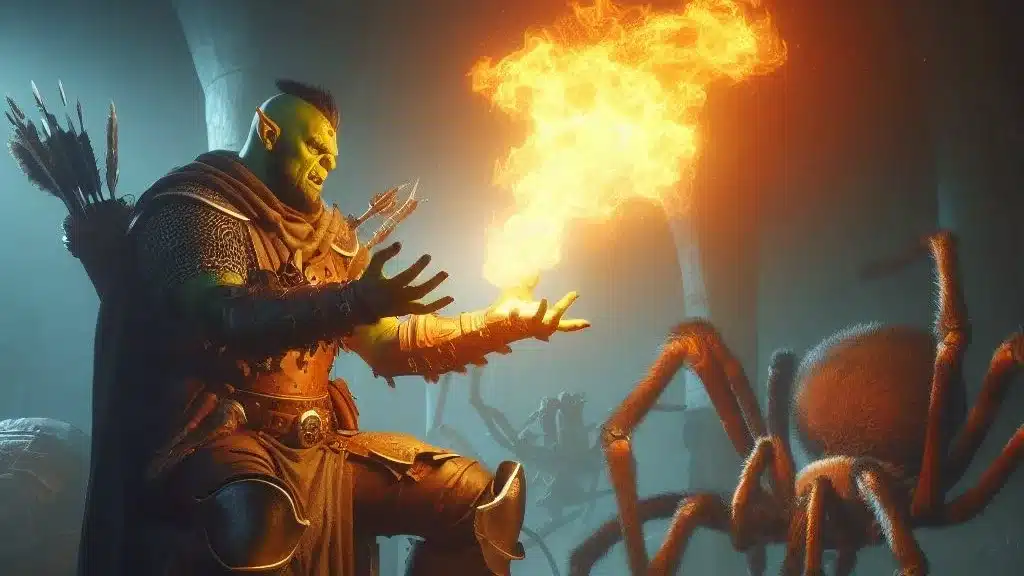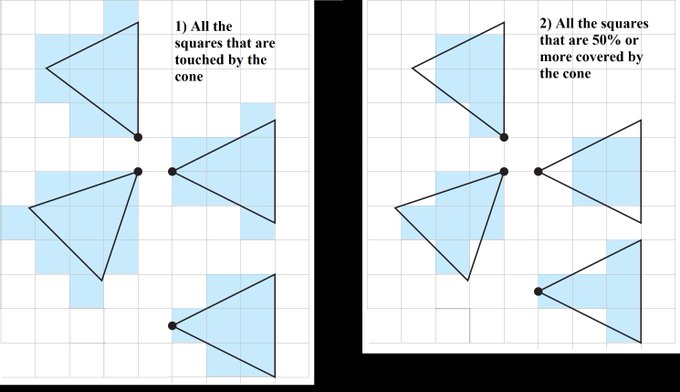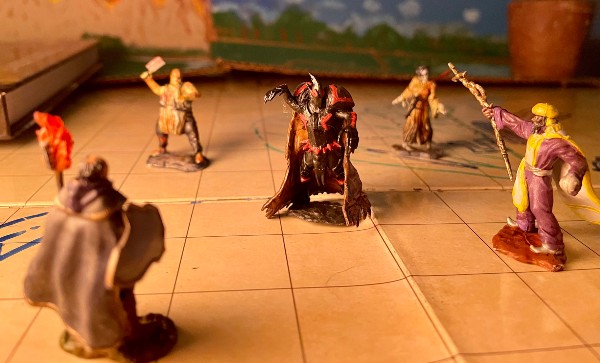As you hold your hands with thumbs touching and fingers spread, a thin sheet of flames shoots forth from your outstretched fingertips. Each creature in a 15-foot cone must make a Dexterity saving throw. A creature takes 3d6 fire damage on a failed save, or half as much damage on a successful one.
The fire ignites any flammable objects in the area that aren’t being worn or carried.
At Higher Levels. When you cast this spell using a spell slot of 2nd level or higher, the damage increases by 1d6 for each slot level above 1st.
Casting Time: 1 action
Range: Self (15-foot cone)
Components: V, S
Duration: Instantaneous
School: 1st-level evocation
Who can cast Burning Hands? Sorcerers and Wizards have on their Burning Hands class spell lists. Light Clerics and Wildfire Druids get Burning Hands on their class spell lists and always have it prepared. Fiend Warlocks and Efreeti Genie Warlocks have Burning Hands on their expanded class spell lists.
Additionally, Monks (Way of the Four Elements) can spend 3 ki points to cast Burning Hands (flavored as “Sweeping Cinder Strike”) starting at 5th level (PHB 81). Monks (Way of the Sun Soul) can also cast Burning Hands (Searing Arc Strike) as a bonus action starting at 6th level (XGtE 35).
Burning Hands 5e
The classic spell that’s great for melting the faces of whoever’s unfortunate enough to be right in front of you, Burning Hands is a staple of DnD spellcasting. It’s a no-nonsense, big-damage, short-range, area-of-effect spell that behaves just as you’d expect a spell like Burning Hands to behave.
That said, there’s still plenty of confusion around this spell in DnD 5e, from just what a “15-foot cone” is to the common “can I re-flavor the damage type” question. I’ll sort all that out, as well as provide a few fun applications for the spell you may have failed to consider.
How Does Burning Hands Work in 5e?
Burning Hands forces all creatures in a 15-foot cone emanating from the caster to make a Dexterity saving throw. The 15-foot range refers to the maximum length of the cone — on a standard “1 inch = 5 feet” battle map; this means Burning Hands extends three squares away from the caster (although the rules are a bit less straightforward than that…)
A creature takes 3d6 fire damage if it fails, or half as much if it succeeds. Flammable objects in the area that are not being worn or carried also ignite.
Burning Hands scales by 1d6 extra damage per upcast level.
Now, onto those less-than-straightforward rules…
What Are the Rules for Burning Hands 5e?
The rules for Burning Hands in DnD 5e are as follows:
-
Any square that Burning Hand’s range touches is affected. Even if only 1% of a square is touched by Burning Hands, a creature on that square must make a saving throw or take full damage from the spell, rules-as-written — only sphere-shaped area of effect spells are excepted from this rule, requiring 50%+ coverage of a square to affect a creature on it (DMG 251).
This was also confirmed on Sage Advice, with a helpful illustration to clarify just what the hell I’m talking about.
The left-hand side shows the correct reading of the rules on cone-shaped area of effect spells.I’ll go into more detail about how cones work in a different section below.
AoE on a grid: You can target someone if any of their space is in the AoE. Spheres are the exception (DMG, 251) #DnD https://t.co/WKXxkXROpG
— Jeremy Crawford (@JeremyECrawford) September 9, 2016
-
Burning Hands only requires one free hand to cast. Burning Hands technically requires the use of two hands (as per the “thumbs touching” text in the spell). However, Jeremy Crawford seems to suggest that it’s fine to cast Burning Hands with only one free hand in this Sage Advice thread — and of course, all DMs are free to do so.
As DM, I allow the casting of a spell with an S component as long as the caster has at least one hand. #DnD https://t.co/ejZswjieZ6
— Jeremy Crawford (@JeremyECrawford) March 21, 2016
Plus, one could easily argue that a clever spellcaster could find a way to hold onto whatever they were holding while still putting their thumbs together and spreading their fingers.
-
Burning Hands is not a touch spell. For Sorcerers looking to apply the Distant Spell metamagic to make Burning Hands bigger, sorry, it doesn’t qualify. Self (AoE) spells are in a weird place where they’re neither ranged nor touch, and so none will qualify for this metamagic.
Sadly, this also means that Wizards and Warlocks cannot use their familiar as a conduit for casting Burning Hands.
-
“Ignite” doesn’t mean “spread like wildfire.” While Burning Hands will ignite flammable objects that are not being worn or carried, that doesn’t mean that these objects become a raging inferno, a la fiendfyre from Harry Potter.
So if you want to burn down a well-built structure with Burning Hands, it’s going to take you a good while, as well as nobody intervening with, say, buckets of water.
-
Burning Hands affects a cone, even if the flame is just a sheet. Twice in one description, Burning Hands leaves us wondering whether its text is flavor or mechanics! This time, the problem comes from the words “thin sheet of flames,” which clearly differs from a cone of flames that the spell’s range/area suggests.
However, for this question, we have no choice but to answer that the spell still affects a cone-shaped region as the game’s rules describe (PHB 204), since Burning Hands’ description gives no mechanical way to interpret the sheet’s specific area of effect.
What does this mean for you? Just that creatures can’t duck and/or jump over Burning Hands if they’re on a tile affected by the spell.
-
Burning Hands hurts allies. All creatures in Burning Hands’ area of effect must make a saving throw and take damage, including allies. This can also include the caster herself, if she decides to include the point of origin (herself) in the spell’s area of effect for some reason (PHB 204).
How to Use Burning Hands in 5e
We’re sure anyone who’s played a spellcaster in a fantasy game already has some ideas on how to use Burning Hands, but here are my two cents:
-
Blast big groups. Yep, the first thing that probably popped into your head is the #1 application of Burning Hands. Get close to a big group of baddies and let your flamethrower hands rip.
Just be sure you have a reliable way to get back out again (or targeting low health/low damage minions), since you’ll be putting yourself close to harm’s way to get in range.
-
Pair with conditions. Burning Hands forces a Dexterity saving throw — many conditions disturb a creature’s ability to make Dexterity saving throws.
Being incapacitated causes a creature to automatically fail Dexterity saving throws, and being stunned, paralyzed, petrified, unconscious, or asleep all count as being incapacitated. Being restrained causes Dexterity saves to be made at disadvantage.
If you or an ally can lead with a spell or effect that somehow incapacitates or restrains a group of enemies, following up with Burning Hands is a devastating combination that’s guaranteed to do full damage.
-
Start fires. Sure, some cantrips can start fires without wasting a spell slot (Fire Bolt, Create Bonfire), but not in such a significant area of effect.
While a 15-foot cone isn’t usually enough to rapidly ruin the structural integrity of a well-built building, it might cause some serious environmental hazards and/or conditions (smoke, heat, trapped rooms, etc.). And if you do want to create a more destructive fire, you can always aid things along with oil and other highly flammable/combustible materials.
-
Cause a stir. You can also use this big blaze as a distraction to pull the silly guards from their post to see what’s up, a way of creating some quick light in a dark space, or to simply wowing some plebs who’ve never seen a gal shoot fire from her fingers before.
Who Can I Target With Burning Hands 5e?
Burning Hands targets a 15-foot cone, emanating from the caster. Let’s go directly to the rulebook for how cone spells work:
A cone’s point of origin is not included in the cone’s area of effect, unless you decide otherwise.
Player’s Handbook, page 204
I’m not great at geometry, but the second line simply states that when the cone is 5 feet away from the caster, it is also 5 feet wide; when the cone is 15 feet away from the caster, it is 15 feet wide.
The third line means that Burning Hands’ maximum length is 15 feet long, at which point it is also 15 feet wide (3 squares wide, if using a 1 inch = 5 feet battle map).
The final line means that the caster can choose to include their own space in the spell’s area of effect, if they choose to. If a caster does choose to do this, they will also need to make a Dexterity saving throw and will take damage from their own spell.
Xanathar’s Guide to Everything provides a few tricks for measuring a cone, including the template method and token method (XGtE 86-87). The template method is much easier to apply and quickly use at your table, so that’s the one I recommend using.
However, the token method is also good for providing some semblance of consistency to how many squares should be affected by an area of effect cone. Specifically, Burning Hands should affect 6 total squares; 1 square adjacent to the caster, 2 squares that are 2 squares distant from the caster, and 3 squares that are 3 squares distant from the caster.
This method would make Burning Hands much weaker than the “use a template and hit at least 1% of a square” method, however, as well as being more cumbersome to apply in-session.
If you want a great deep dive into how cone spells work in DnD 5e, this video by Treantmonk’s Temple does a better job than I can:
Is Burning Hands 5e a Good Spell?
Yes, Burning Hands is a good spell. In fact, it has the highest average damage roll (10.5) of any 1st-level area of effect spell in DnD 5e. This big damage is paid for with big risk, though, as a spellcaster has to get within 15 feet of the creatures they hope to target.
Still, a chance to deal 30-60 damage in one round of combat as a 1st-level spellcaster undeniably makes Burning Hands a good spell. And the upcast potential for +3.5 average damage per slot level above the first really adds up when you’re hitting multiple enemies at once.
On the slightly negative side, Burning Hands deals fire damage, one of the more common resistances and immunities in the game (although this fact’s importance is often overhyped).
Burning Hands 5e Compared to Fireball
While 1st-level players might be stoked (heh) to get their hands on some fiery goodness, long-term planners might ask themselves whether Burning Hands will simply get outclassed as they level up.
The answer is yes, Burning Hands does get eclipsed by Fireball when the third-level spell becomes available to you.
Upcasting Burning Hands to a 3rd-level spell brings its damage up to 5d6 compared to Fireball’s 8d6. Fireball has a 150-foot range and affects a 20-foot radius sphere (much larger than a 15-foot cone). Fireball relies on the same saving throw and also ignites non-worn/carried flammable objects, so that part’s a wash.
The only time when Burning Hands is the superior option is when collateral damage is an issue. If Fireball’s huge radius is a liability to your allies, the more focused flame offered by Burning Hands might be the right choice.
Does that mean there’s no point in taking Burning Hands? No. 3rd-level spells don’t become available until at least 5th level, and you certainly won’t regret having Burning Hands for levels 1-4.
Burning Hands 5e DM Tips
I’ve got three tips for DMs regarding Burning Hands:
-
Let players cast Burning Hands with one hand. As a DM, it’s up to you to decide whether you actually require the caster to touch their thumbs together and spread their fingers in order to cast Burning Hands, and whatever other requirements come with this.
Personally, I think players should be allowed to cast any spell with a somatic component as long as they have one free hand.
But I do, from time to time, ask my player to describe exactly how they hold onto their staff while putting their thumbs together and spreading their fingers apart. This isn’t to suggest that they can’t pull it off — I just find it’s a good opportunity to introduce humor, give a nod to the spell’s flavor text, and make the spellcaster feel extra cool for their fire-blasting feat.
-
Be consistent with flammable objects. A DM’s job is always tricky with spells that ignite flammable objects. It’s up to you just how quickly those flames spread, how creatures in the environment react to open flames, and what structural damage, if any, they’re capable of causing.
You might also have to adjudicate a player trying to douse a creature in oil and then setting it ablaze — have fun with that one.
Of course, I always recommend going with the “rule of cool” in the moment when players have a flash of inspiration like this. But I also recommend trying your best to remain consistent with how spells and effects work, so players don’t get unrealistic expectations about the destructive power of their Burning Hands.
-
Allow re-flavors, if it makes sense. Some players want to re-flavor Burning Hands to a different damage type because they don’t feel that fire represents who they are as spellcasters. In general, there’s nothing wrong with this.
However, the DnD designers did make mechanical choices related to damage types. Specifically, spells that deal fire damage tend to deal more damage, but that’s offset by fire damage being more frequently resisted by creatures. Overall, I think this argument is overhyped — but it is an argument.
My feeling is that if a player wants to change Burning Hands to Lightning Hands because they imagine their Wizard as an acolyte of a storm god, go ahead and let them.
But if a player wants to change Burning Hands to Lightning Hands because they know your campaign features a lot of fire-resistant and/or lightning-vulnerable baddies, then maybe look at the request less favorably.
DnD 5e Burning Hands FAQ
Burning Hands DnD 5e FAQ:
-
Do Tieflings get Burning Hands? Yes, Tieflings can get Burning Hands if they choose the Bloodline of Mephistopheles variant, are Variant Tieflings from the Sword Coast Adventurer’s Guide, or are Abyssal Tieflings (randomly selected). These racial variants provide access to the Burning Hands spell once per long rest without expending a spell slot.
-
Is Burning Hands overpowered? No, Burning Hands is not considered overpowered. While it can deal decent damage in a cone, its range is limited, and it requires the caster to be relatively close to the targets. It’s a fair risk-reward spell for spellcasters.
-
Does Burning Hands really require touching thumbs? Yes? I mean, it’s flavor text, but even if it does, you still only need one free hand to cast it. Jeremy Crawford confirmed this is how he runs it, anyway.
https://www.sageadvice.eu/how-is-a-character-supposed-to-cast-burning-hands-with-one-hand/
Simple Burning Hands 5e Spell Text
Burning Hands: (1st-level evocation, Self (15-foot cone), V/S) Force Dexterity saving throws for all creatures in range. A creature takes 3d6 fire damage on a failed save, of half as much on a success. The fire ignites flammable objects in the area that aren’t being worn or carried. | +1d6 per slot level above 1st
How to Use Other Evocation Spells in DnD 5e
D&D 5e Booming Blade
D&D 5e Eldritch Blast
D&D 5e Fire Bolt
D&D 5e Frostbite
D&D 5e Green-Flame Blade
D&D 5e Light
D&D 5e Lightning Lure
D&D 5e Sacred Flame
D&D 5e Shocking Grasp
D&D 5e Thunderclap
D&D 5e Word Of Radiance
D&D 5e Chromatic Orb
D&D 5e Cure Wounds
D&D 5e Faerie Fire
D&D 5e Guiding Bolt
D&D 5e Healing Word
D&D 5e Hellish Rebuke
D&D 5e Magic Missile
D&D 5e Searing Smite
D&D 5e Thunderous Smite
D&D 5e Thunderwave
D&D 5e Witch Bolt
D&D 5e Darkness
D&D 5e Scorching Ray
D&D 5e Shatter
D&D 5e Spiritual Weapon
D&D 5e Aura Of Vitality
D&D 5e Daylight
D&D 5e Sending
D&D 5e Leomund’s Tiny Hut



![Spike Growth 5e [DnD Spell Guide: Uses, Rules, Tips] entangle-5e-druid](https://www.dndlounge.com/wp-content/uploads/2022/03/entangle-5e-druid-300x174.jpg)
![Shillelagh 5e [DnD Spell Guide: Uses, Rules, Tips] owlbear-dnd-5e](https://www.dndlounge.com/wp-content/uploads/2022/03/owlbear-dnd-5e-300x218.jpg)
![Shape Water 5e [DnD Spell Guide: Uses, Rules, Tips] dnd-5e-character-sheet-and-die](https://www.dndlounge.com/wp-content/uploads/2022/03/dnd-5e-character-sheet-and-die-300x157.jpg)
![Aura of Vitality 5e [DnD Spell Guide: Uses, Rules, Tips] dungeons-and-dragons-party-vs-blue-dragon](https://www.dndlounge.com/wp-content/uploads/2022/03/dungeons-and-dragons-party-vs-blue-dragon-300x223.jpg)